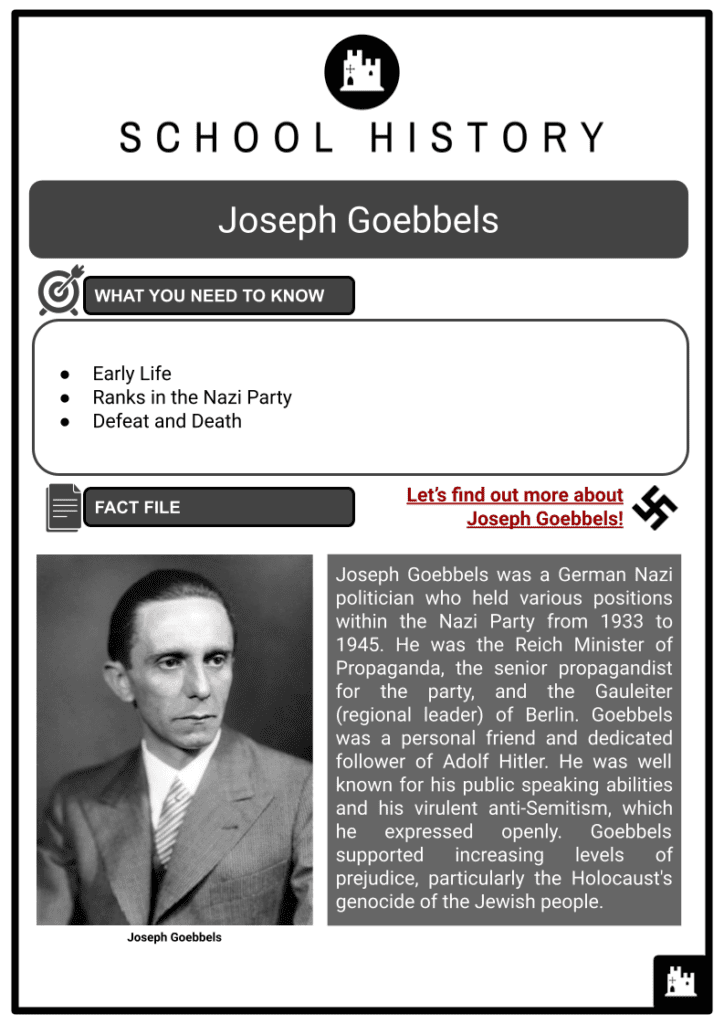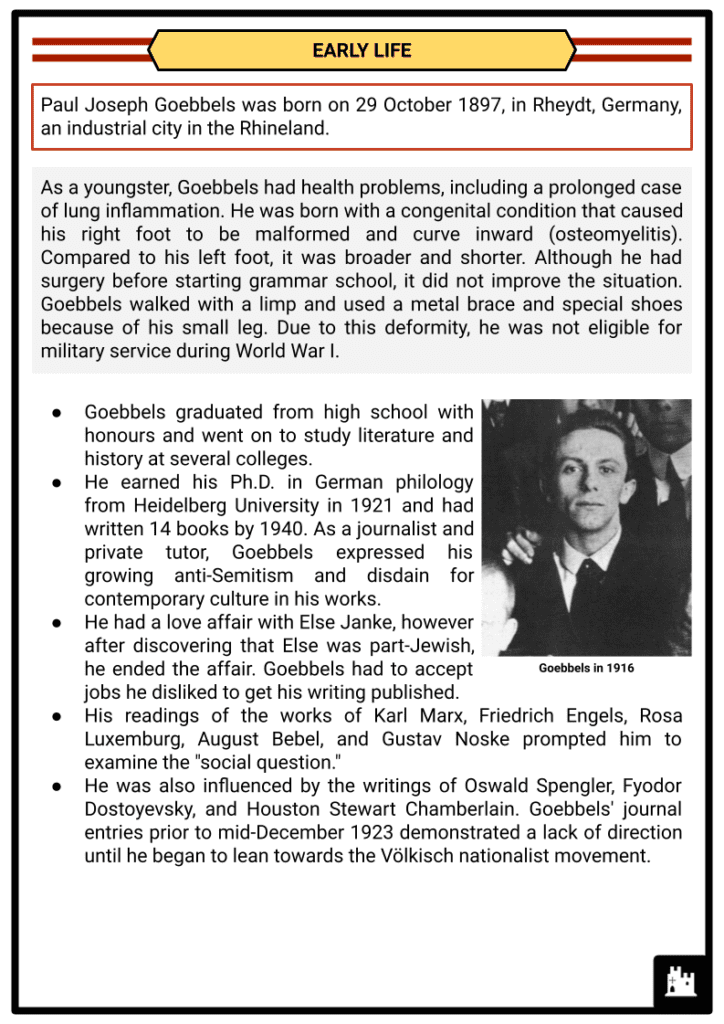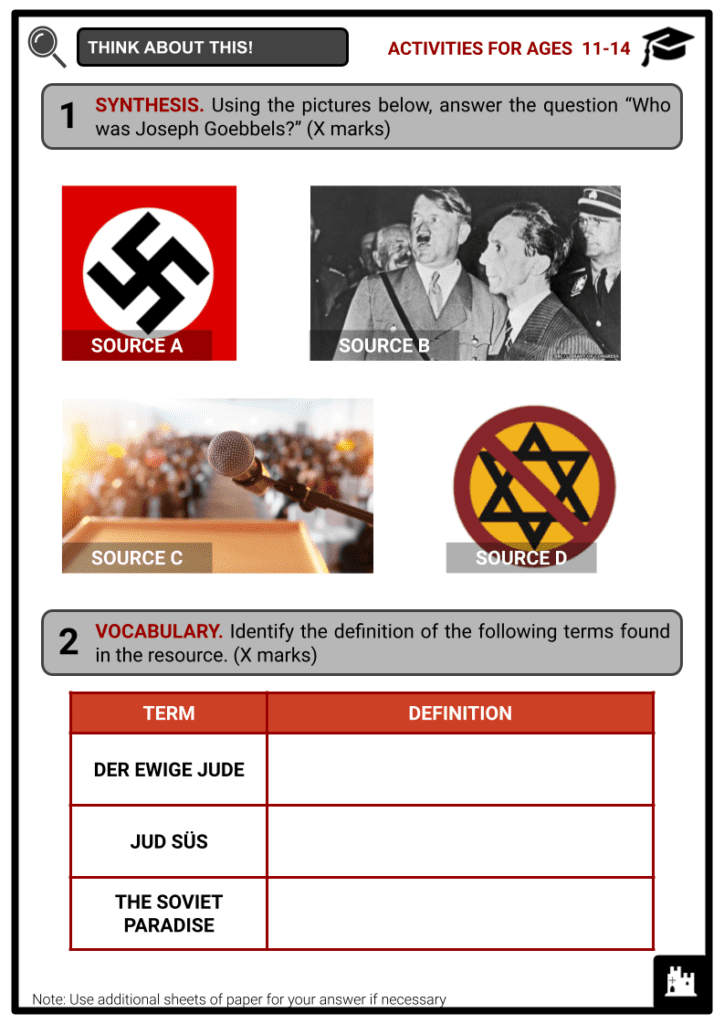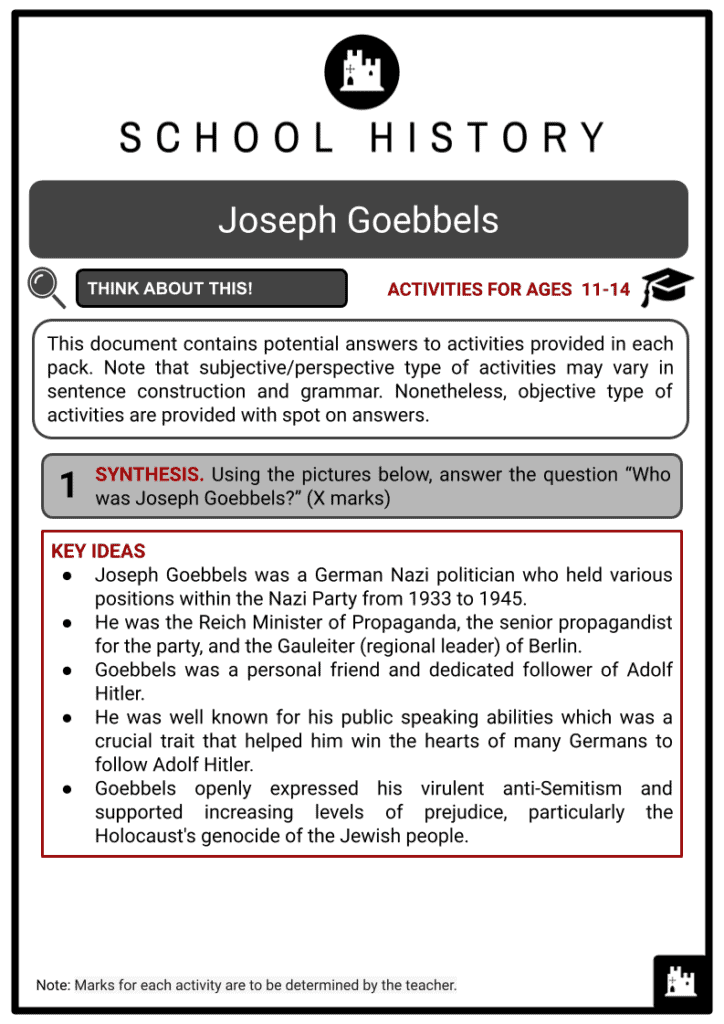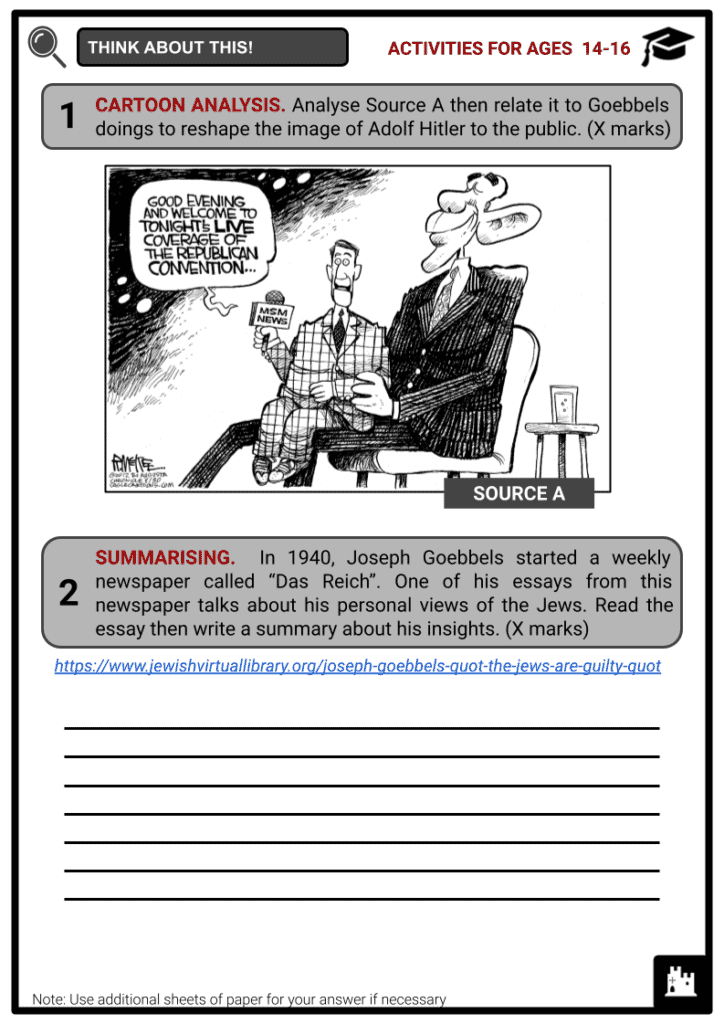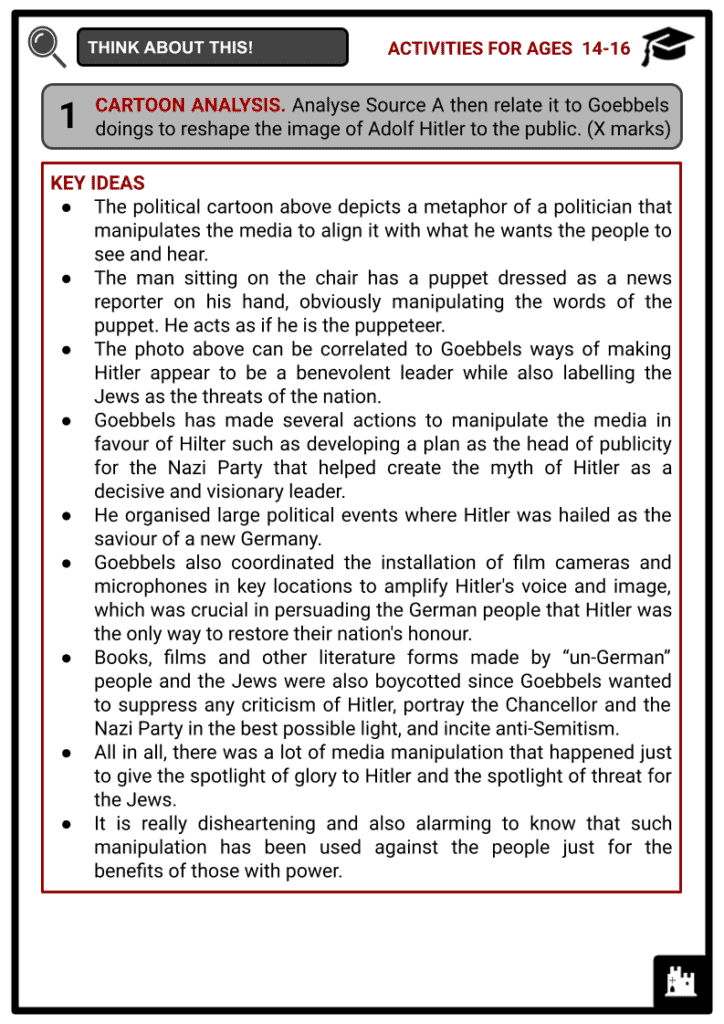Joseph Goebbels Worksheets
Do you want to save dozens of hours in time? Get your evenings and weekends back? Be able to teach about Joseph Goebbels to your students?
Our worksheet bundle includes a fact file and printable worksheets and student activities. Perfect for both the classroom and homeschooling!
Summary
- Early Life
- Ranks in the Nazi Party
- Defeat and Death
Key Facts And Information
Let’s find out more about Joseph Goebbels!
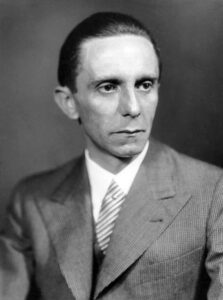
Joseph Goebbels was a German Nazi politician who held various positions within the Nazi Party from 1933 to 1945. He was the Reich Minister of Propaganda, the senior propagandist for the party, and the Gauleiter (regional leader) of Berlin. Goebbels was a personal friend and dedicated follower of Adolf Hitler. He was well known for his public speaking abilities and his virulent anti-Semitism, which he expressed openly. Goebbels supported increasing levels of prejudice, particularly the Holocaust's genocide of the Jewish people.
EARLY LIFE
- Paul Joseph Goebbels was born on 29 October 1897, in Rheydt, Germany, an industrial city in the Rhineland.
- As a youngster, Goebbels had health problems, including a prolonged case of lung inflammation. He was born with a congenital condition that caused his right foot to be malformed and curve inward (osteomyelitis). Compared to his left foot, it was broader and shorter. Although he had surgery before starting grammar school, it did not improve the situation. Goebbels walked with a limp and used a metal brace and special shoes because of his small leg. Due to this deformity, he was not eligible for military service during World War I.
- Goebbels graduated from high school with honours and went on to study literature and history at several colleges.
- He earned his Ph.D. in German philology from Heidelberg University in 1921 and had written 14 books by 1940. As a journalist and private tutor, Goebbels expressed his growing anti-Semitism and disdain for contemporary culture in his works.
- He had a love affair with Else Janke, however after discovering that Else was part-Jewish, he ended the affair. Goebbels had to accept jobs he disliked to get his writing published.
- His readings of the works of Karl Marx, Friedrich Engels, Rosa Luxemburg, August Bebel, and Gustav Noske prompted him to examine the "social question."
- He was also influenced by the writings of Oswald Spengler, Fyodor Dostoyevsky, and Houston Stewart Chamberlain. Goebbels' journal entries prior to mid-December 1923 demonstrated a lack of direction until he began to lean towards the Völkisch nationalist movement.
- In the early 1920s, Goebbels joined the National Socialist German Workers' (Nazi) Party after unsuccessful attempts to launch a career as a journalist, novelist, and playwright. The Nazi Party promoted anti-Semitism and German nationalism. Eventually, Goebbels met the party's leader, Adolf Hitler. The German economy was in disarray at the time due to inflation, and the country's citizens were demoralised after their defeat in World War I.
- Both Hitler and Goebbels believed that words and images could be powerful tools for exploiting this dissatisfaction. While Goebbels admired Hitler's ability to speak to large crowds and use words and gestures to stir up German patriotism, Hitler was impressed by Goebbels' ability to articulate his ideas in writing.
RANKS IN THE NAZI PARTY
- Goebbels swiftly ascended through the ranks of the Nazi Party. He initially aligned with Gregor Strasser, the leader of the more anti-capitalist party faction, but later turned against him and joined forces with the more traditional Hitler. In 1926, he became the party district leader in Berlin. The following year, he established a weekly journal called Der Angriff (The Attack), which promoted the Nazi Party's views, and contributed to it.
- In 1928, Goebbels was elected to serve in the Reichstag, the German parliament.
- More importantly, Hitler appointed him as the head of publicity for the Nazi Party.
- In this role, Goebbels developed the plan that helped create the myth of Hitler as a decisive and visionary leader.
- He organised large political events where Hitler was hailed as the saviour of a new Germany.
- Goebbels also coordinated the installation of film cameras and microphones in key locations to amplify Hitler's voice and image, which was crucial in persuading the German people that Hitler was the only way to restore their nation's honour.
- In January 1933, Hitler was elected as German Chancellor, and in March of that same year, he appointed Goebbels as the Minister of Publicity and Public Education. In this position, Goebbels had complete control over the content of German periodicals, books, music, films, stage productions, radio programmes, and works of art. His goal was to suppress any criticism of Hitler, portray the Chancellor and the Nazi Party in the best possible light, and incite anti-Semitism.
- In April 1933, at Hitler's behest, Goebbels organised a boycott of Jewish businesses. The following month, he helped organise the burning of "un-German" literature in a formal ceremony at the Berlin Opera House. Works of numerous authors were destroyed, including non-Germans such as Émile Zola, Helen Keller, Marcel Proust, Upton Sinclair, Sigmund Freud, H.G. Wells, Jack London, and André Gide, as well as German-born authors Erich Maria Remarque, Arnold Zweig, Thomas Mann, Albert Einstein, and Heinrich Mann.
- In September 1933, Goebbels was appointed director of the newly established Reich Chamber of Culture, with the responsibility of overseeing all facets of the arts. The chamber's establishment resulted in the forced unemployment of all Jewish creatives, including authors, composers, actors, and directors in theatre and cinema. Goebbels gave the order to remove all such "decadent" artwork and replace it with more realistic and emotional pieces because the Nazis believed modern art to be evil. In October, the Reich Press Law was passed, mandating the dismissal of all Jewish and non-Nazi editors from German periodicals.
- When World War II began in 1939, Goebbels was tasked with motivating the German people and using the media, particularly the movie industry, to persuade the populace to support the war effort. One of the projects he sponsored was "Der ewige Jude," also known as "The Eternal Jew," a propaganda film that purported to map out the history of the Jews. In the movie, Jews were portrayed as parasites that messed up an otherwise orderly environment.
- Goebbels also oversaw the creation of Jud Süss, a motion picture chronicling the life of Jewish financial advisor Josef Süss Oppenheimer, who in the early 18th century collected taxes for Duke Karl Alexander of Württemberg, ruler of the Duchy of Württemberg. Oppenheimer was tried and put to death after the Duke passed away unexpectedly. Under Goebbels's management of the film, the narrative of Jud Süss was converted from a personal tragedy to an allegory about Jewish self-importance and avarice.
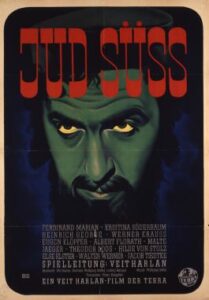
Jud Süs - In 1942, Goebbels orchestrated "The Soviet Paradise," a huge Nazi propaganda display that was exhibited in Berlin. The exhibition served to strengthen the determination of the German people by exposing the deceit of Jewish Bolsheviks. On 18 May, the exhibition was partially destroyed when German-Jewish Resistance commander Herbert Baum and his allies set it on fire. Baum was located in Berlin. Goebbels vehemently objected to the incident being covered by the German media. Baum and his small but tenacious team nonetheless managed to deal Goebbels and his propaganda apparatus a significant psychological blow.
DEFEAT AND DEATH
- Goebbels advocated fighting to the death against the Allied forces as the war dragged on and the number of German losses rose. He used his own charismatic public speaking skills to energise the German people. On one occasion in August 1944, he ordered the German people to support a full-scale war effort while addressing Berlin's Sports Palace. He reasoned that the annihilation of the German country and people was appropriate if Germany was doomed to lose the war.
- The Nazi dictatorship believed that the German defeat was inevitable as 1944 gave way to 1945. Goebbels remained staunchly faithful to Hitler while other Nazi higher-ups spoke with the Allies with the goal of securing favourable treatment following the German capitulation.
- Adolf Hitler, the head of Nazi Germany, was surrounded in his bunker in Berlin during the closing stages of World War II as Soviet forces drew closer. Only a small group of his followers were left by this point as most of his top officials had either fled or been kidnapped. One of them was Joseph Goebbels, Hitler's personal confidant and minister of propaganda.
- Hitler's behaviour grew more unpredictable and paranoid as the situation worsened. He felt that Germany had betrayed him and that the war was lost. Along with his new wife, Eva Braun, Hitler shot himself in the head on 30 April 1945 in his bunker. He may have also taken a cyanide tablet to ensure his death.
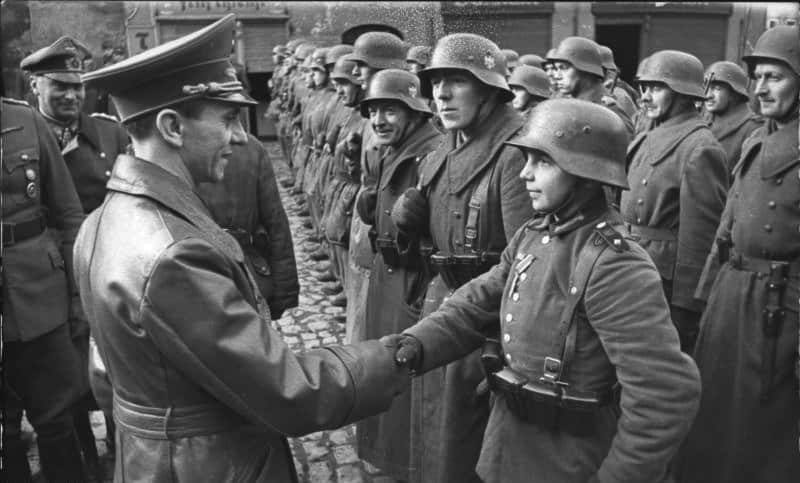
Goebbels and the Hitler Youth - The question of who would rule Germany after Hitler's death arose. Goebbels was appointed chancellor in one last gesture of allegiance, although his term was brief. The next day, on 1 May 1945, Goebbels and his wife Magda poisoned their six children with cyanide in the bunker. The children ranged in age from 4 to 12 years old. Goebbels shot Magda before killing himself as the pair committed suicide.
- There has been substantial disagreement over the specifics of Goebbels' death. While some accounts contend that he died as a result of the gunshot wound, others maintain that he also consumed cyanide. Whatever the case may be, the Goebbels family's demise marked the terrible conclusion of a troubling period in human history. The events in the bunker over those last few days serve as a chilling reminder of the dreadful consequences of authoritarianism, brutality, and hatred.
Image Sources
- https://en.wikipedia.org/wiki/Joseph_Goebbels#/media/File:Bundesarchiv_Bild_146-1968-101-20A,_Joseph_Goebbels.jpg
- https://en.wikipedia.org/wiki/Jud_S%C3%BC%C3%9F#/media/File:Jud_S%C3%BC%C3%9F_poster.jpg
- https://en.wikipedia.org/wiki/Joseph_Goebbels#/media/File:Bundesarchiv_Bild_183-J31305,_Auszeichnung_des_Hitlerjungen_Willi_H%C3%BCbner.jpg

